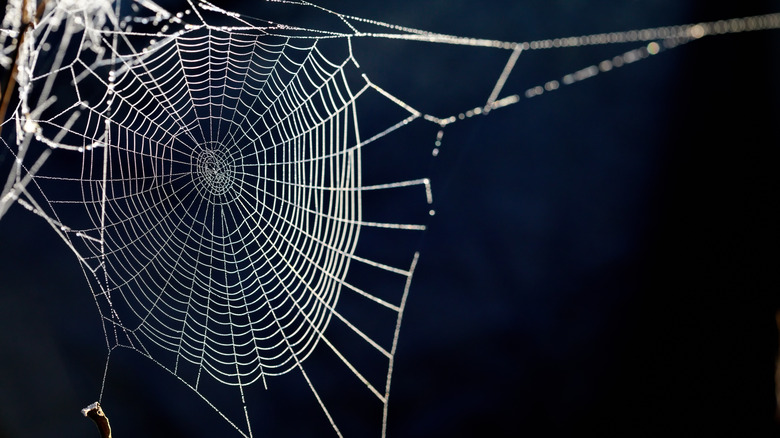DIY The Spookiest Halloween Decor With A Modern Take On Traditional Spider Web Painting
We may receive a commission on purchases made from links.
Halloween decoration ideas often skew towards simple, straightforward pieces like orange pumpkins, plastic skeletons, and maybe a few ghosts. But some spooky art forms reach much further back in history and can give your Halloween decorations a truly unique twist. We're talking about spider web paintings. Dating back to approximately the 1500s, European monks used to paint religious icons and scenes on delicate canvases made of old spiderwebs (via Atlas Obscura). While weaving an entire canvas out of spiderwebs is mostly a lost art form at this point, there is an alternative method for evoking the wispy, spooky qualities of spiderweb painting that still uses real webs. For a modern take on spiderweb painting, transfer a cobweb to a painted canvas board and preserve it with a coat of varnish.
As shared by TikTok user @lunaremilie, this artsy Halloween project requires minimal art skills and just a few basic materials. You'll need a canvas or canvas board, which can be found at any craft store or online retailer, such as these canvas panel boards from Amazon. You'll also need acrylic spray paint, clear paint, and varnish. For the varnish, get one that's meant for acrylic paint, like the Liquitex Basics Gloss Varnish. To add more creative touches to your spiderweb art, feel free to gather up your favorite specialty acrylic paints — any fun colors or unique finishes are perfect for spooky abstract art. And don't forget, you'll need to find the centerpiece for your project: a spiderweb.
How to make a preserved spiderweb painting
Preserved spiderweb paintings might look intricate and complex, but the process of making one is actually quite simple. Start by finding an abandoned spiderweb. You should always use a cobweb, not an active spiderweb, for this project — aside from it being a little unkind to steal a spider's home, you also don't want to risk any spider bites. Once you have selected your cobweb (or multiple cobwebs, if you want to do a layered piece), spray it with white spray paint. Depending on where the web is located, you may want to hold a piece of cardboard behind the web while you spray the paint, to avoid getting paint on a wall or patio. Give the spray paint a moment to dry, and then carefully transfer the spiderweb onto a painted canvas. Even with a coat of paint, the web will still be very delicate, so the easiest way to do the transfer is to gently push the canvas into the cobweb, allowing the web to stick to the surface.
With the web on the canvas, you can now preserve it with clear paint and a layer of varnish. This will seal in the web and help keep it from deteriorating. After the clear paint and varnish dry, you're free to add any other creative elements to the piece. Experiment with novelty mediums like neon, sparkly, or glow-in-the-dark paints. Your result will be spooky, textured art that's sure to make an impact.
